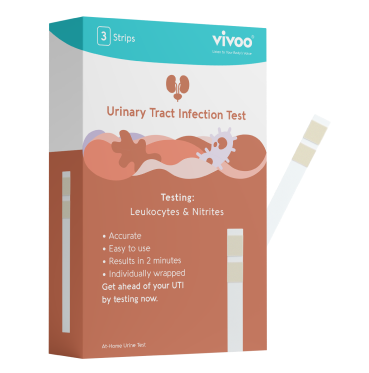Calcium is one of the most important electrolytes for the human body and plays an essential role in wellness. It is one of the most abundant minerals in the human body [1]. The majority of calcium in our body is stored in our bones and teeth (99%), with the remainder found in soft tissues and blood (1%), which is important for good health.
It’s important to track your calcium levels because both high and low calcium levels can adversely impact your well-being. Thankfully, Vivoo offers a straightforward and fuss-free way of keeping an eye on your calcium levels anytime and anywhere, even when you’re at home!
How Much Calcium Should You Take Daily?
We lose calcium every day through our hair, sweat, urine, and feces. Because the body cannot make calcium, you have to obtain calcium through the foods you eat or from supplements. How much calcium you need a day depends on your age and biological sex.
Here’s how much calcium you need based on your age:
-
14–18 years: 1,300 mg [6]
-
19–50 years: 1,000 mg
-
51-70 years: 1,000 mg for men and 1,200 mg for women
-
71 years and older: 1,200 mg
-
Pregnant and lactating women need 1,000-1,300 mg depending on age.
It’s possible to get sufficient amounts of calcium through the foods you eat daily. That said, you should still pay attention to your calcium intake to be sure that you are meeting your daily requirements. Also, it is important to note that your body needs vitamin D to absorb calcium. That’s why you should also be mindful of your vitamin D intake in addition to calcium [3].
The amount of calcium in the body depends on many factors, including:
-
The rate of calcium intake from food
-
The amount of calcium and vitamin D absorbed through the intestines
-
Various hormone levels, such as parathyroid or estrogen hormones
Calcium deficiency occurs when the blood has low calcium levels. It’s important to note that early-stage calcium deficiency may not cause any symptoms. Fortunately, testing can still detect calcium deficiency even at an early stage [4]. For instance, urine calcium levels reflect dietary calcium intake.
What is Calcium Good for?
Some of the primary functions and benefits of calcium in the body are:
Strong Bones and Teeth: Calcium helps keep your bones and teeth strong. It's the building block for your skeleton.
Muscle Power: It helps your muscles work. When your brain tells your muscles to move, calcium is part of the message that makes your muscles contract.
Nerve Signals: Calcium is like the messenger that helps your nerves send signals to each other. It's how you feel things and move your muscles.
Keeping the Pressure in Check: Calcium might help your blood vessels relax and squeeze, which can help regulate your blood pressure.
Calcium Sources
Your body cannot produce calcium on its own. This means you have to obtain it from external sources like food or supplements.
Calcium is found in a variety of foods. Some of these foods include:
-
Dairy products (yogurt, cheese, milk)
-
Fish with soft and edible bones (canned salmon, sardines)
-
Dark leafy greens (spinach, collard greens, kale)
-
Calcium-fortified beverages, foods, and cereals (fruit juices, bran, raisins)
-
Fortified soymilk
-
Enriched waffles, bread, grains
-
Seeds (chia seeds, sesame, poppy) [6]
How Can You Test Calcium Levels at Home with Vivoo?
If you’ve decided to test your body’s calcium levels, then there are a few different ways to go about it. If you visit your physician, they might recommend you to take a blood test, one of the most common methods for testing calcium levels.
On the other hand, another method to assess your calcium levels is through a urine test, helping you determine whether you are obtaining sufficient calcium. This test is easily accessible and can be conducted conveniently from the comfort of your home.
Unlike other basic at-home urine tests, Vivoo will label and score you on your calcium levels, and then depending on your label and score, provide you with actionable advice to improve or maintain your calcium levels. Once you take a Vivoo test, the Vivoo App will then provide you with personalized nutritional and lifestyle advice to help you boost your wellness score. All advice on the App has been prepared by dietitians and nutritionists.
How to Evaluate Possible Results?
Vivoo measures your calcium levels and uses your results to share personalized lifestyle and nutritional advice:
- Score: 3/10 and 5/10
- Label: Low
- Value: 0.01 - 0.08 mg/mg Ca/Cr
As the term implies, a low urine calcium level indicates that the calcium level in your urine is lower than average. There are no early-stage symptoms of having a low level of calcium because your body will first try to regulate this by leaching the mineral from the bones.
There are many causes of low urine calcium levels, such as:- Vitamin D deficiency
- Inadequate absorption of ingested nutrients
- Poor calcium intake
- Muscle aches, cramps, and spasms
- Pain in the arms and legs, especially when walking or moving [3,4]
- Fatigue
- Sensitive teeth
- Painful premenstrual syndrome
- Score: 10/10
- Label: Optimal
- Value: 0.1 - 0.3 mg/mg Ca/Cr
An optimal urine calcium level means that the calcium levels in your urine are normal. Typically, you need to be intentional about increasing your calcium intake to achieve this optimal level, whether it be through making smart food and drink choices.
Meeting your daily calcium requirements is important because it helps:- Ease the symptoms of PMS
- Weight management (5)
- Score: 06/10 and 8/10
- Label: High
- Value: B0.4 - 3.96 mg/mg Ca/Cr
A high urine calcium level occurs when the calcium levels in your urine are higher than expected.
There may be different reasons for this, such as:- Excessive vitamin D intake
- High calcium intake (especially among individuals taking supplements)
High urine calcium levels may not cause any immediate signs or symptoms, but can hurt your body system in the long term. You can boost your calcium levels quickly through medications or supplements. Regardless of the method you choose to raise your calcium levels, ensure that you’re meeting your daily recommended intake to achieve optimal wellness.
When You Should Test Your Calcium Levels?
Testing your calcium levels is typically done when there is a suspicion of a calcium deficiency or an underlying medical condition that may affect your calcium metabolism. Here are some situations in which you might consider testing your calcium levels:
-
When you want to evaluate whether your calcium intake is sufficient.
-
Experiencing symptoms of calcium deficiency, including muscle cramps, fatigue, and brittle nails, and dental problems.
-
Taking vitamin D supplements, for calcium absorption.
-
Taking medications that can include calcium.












